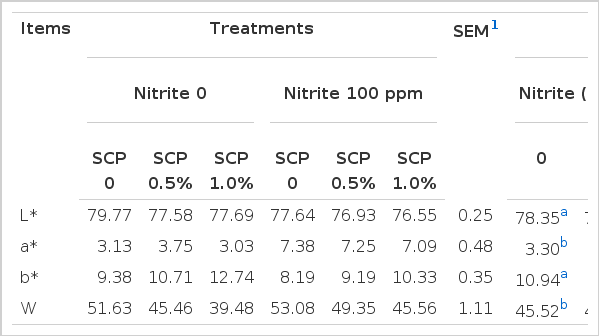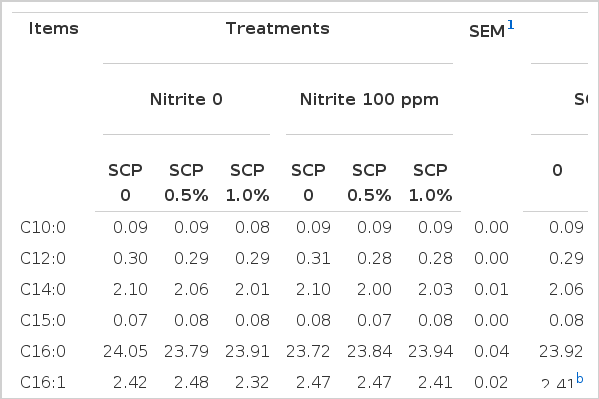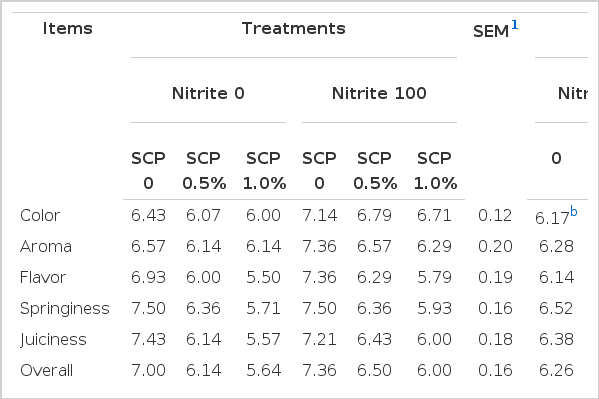Effect of the Addition of Schisandra chinensis Powder on the Physico-chemical Characteristics of Sausage
Article information
Abstract
The individual and interactive effects of Schisandra chinensis powder (SCP) and sodium nitrite additions on color, pH, water holding capacity, residual nitrite, 2-thiobarbituric acid reactive substances (TBARS), volatile basic nitrogen, texture properties, fatty acids, amino acids and sensory evaluation of cooked pork sausages were investigated after 20 d of storage at 4°C. The powders (0, 0.5 and 1.0%) were added to sausages either alone or in combination with nitrite (0 and 100 ppm). SCP added-sausages showed lower L* (lightness) and W (whiteness) values, and higher b* (yellowness) values than sausage containing no nitrite, and exhibited the highest a* values at a 0.5% addition (p<0.05). Residual nitrite and TBARS values were found to be significantly reduced as the addition levels of SCP increased (p<0.05). As the addition of SCP increased, the sausage showed gradually decreased brittleness, cohesiveness, springiness, gumminess and chewiness, while adhesiveness increased. Polyunsaturated fatty acid, n-6 and n-6/n-3 fatty acid ratio concentrations were significantly higher in sausages containing SCP (p<0.05). The addition of SCP to sausage significantly (p<0.05) increased the ammonia content (by 0.5% SCP) and aromatic amino acid concentrations (by 1.0% SCP) (p<0.05). Inclusion of SCP in sausage meat resulted in a significant deterioration in quality characteristics of flavor, springiness, juiciness and overall acceptability (p<0.05). As expected, the observed changes in a*, W, pH, shear force, texture property, TBARS, fatty acid, amino acid and sensory score of sausages, depended on the rate of addition of nitrite (p<0.05). These results suggest that SCP addition is not an effective way of improving the sensory evaluation of sausages, but may beneficially affect TBARS, nitrite scavenging activity, fatty acid and amino acid content in pork sausages.
INTRODUCTION
Many processed meat products contain sodium nitrite, and although the application of sodium nitrite to meat products is controversial, the addition of sodium nitrite has been applied in meat industry for many years. The addition of nitrite contributes to the formation of the characteristic red color, growth inhibition of spoilage and pathogenic bacteria (such as Clostridium botulinum), the development of a typical cured meat flavor, and delayed oxidative rancidity (Marco et al., 2006). However, excessive consumption of nitrite may also present a risk to human health, due to possible allergenic effects, vasodilator effects, metmyoglobin production, and the production of carcinogenic nitrosamines (Jin et al., 2012). Consumption of meat products has increased consistently in Korea since the 1990’s, and in more recent years, consumers have developed a stronger negative view towards artificial additives. As a result, throughout the past several decades, the substitution of nitrite with alternative ingredients has been extensively studied, and it is generally accepted that plant derived foods, such as wine, fruits, nuts, vegetables, grains, legumes and spices, benefit the quality of pork sausages (Kang and Lee, 2003; Zarringhalami et al., 2009; Jung et al., 2010; Maqsood et al., 2012).
Schisandra chinensis (SC), the magnolia vine, growing in northern Korea, Japan, China, and adjacent regions in Russia, has a long history of association with health care as a medicinal plant. S. chinensis had been determined to contain a variety of ligans, which are known to be important bioactive compounds, and which are believed to be responsible for the reported pharmacological activities of the plant, such as the prevention of hepatitis, stimulation of liver regeneration, inhibition of hepatocarcinogenesis, and improvement of human intellectual activity (Wang et al., 2007). To date, SC extracts have been applied mainly to processed products, such as beverages, alcoholic drinks and teas, due to its red color pigment and health benefits. Although the physiological and pharmacological functions of SC have been extensively studied, little study has been directed towards its effect on the quality of sausages.
The aim of this study was to determine the individual and cumulative effects of sodium nitrite and SC powder on the physicochemical properties of cooked pork sausages after 20 d of storage at 4°C.
MATERIALS AND METHODS
Preparation of Schisandra chinensis powders
Air dried Schisandra chinensis fruits were purchased from a herbal market (Kumho market, Seoul, Korea), and after grinding for 1 min, SC powder was boiled in distilled water (1:10) for 3 h. The mixture was then filtered, and evaporated in a vacuum at a temperature of 70°C using a rotary evaporator (RW-0525G, Heidolph, Germany). The extracts were dried in a freeze drier and were then finely powdered.
Experimental design and sausage processing
Approximately 22 kg of commercial pork loin meat was obtained from a local commercial store, and visible fat and connective tissues were removed. All trimmed pork loins were coarse ground (MGB-32, Hankook Fujee Industries Co. Ltd., Suwon, Republic of Korea) and were weighed to allot pork loins into six different groups of 3 kg. Each group was then mixed (Table 1) and was ground to a fine texture. Nitrite and/or SCP were added to the mixture as follows: i) 0 ppm nitrite and 0% SCP (control); ii) 0 ppm nitrite and 0.5% SCP; iii) 0 ppm nitrite and 1.0% SCP; iv) 100 ppm nitrite and 0% SCP; v) 100 ppm nitrite and 0.5% SCP; and vi) 100 ppm nitrite and 1.0% SCP. Each sample was then mixed for a further 2 min to achieve a uniform distribution of the nitrite and/or SCP in the matrix (A-20, Ramon Co. Ltd., Oiartzun, Spain). Approximately 160 g of each mixture was used to stuff the sausages, (E-25, Hankook Fujee Industries Co. Ltd., Suwon, Republic of Korea), and 15 cm long sausages of 3 cm diameter were formed (Krehalon UK Ltd., East Riding of Yorkshire, UK). All sausages were placed in a water bath (BS-31, Jeio Tech. Co. Ltd., Seoul, Republic of Korea), and were uniformly cooked at 100°C, removed when the internal temperature reached 74°C, and were cooled at 4°C in a refrigerator for 1 h. Each sausage was subsequently packed and covered with a polyvinyl chloride film (Krehalon UK Ltd., East Riding of Yorkshire, UK). All sausages from the six different treatments were stored at 4°C prior to chemical analysis and sensory evaluation after days 20 of storage.
Evaluation of sausage color
The color of sausages were measured as L*, a* and b* values using a colorimeter (Minolta Chroma Meter CR-300, Minolta Co., Ltd., Ramsey, NJ, USA) which was calibrated with a white standard plate (Y = 92.8, x = 0.3134, and y = 0.3193). Sausages were cut into slices of 3 cm lengths and the surface color was measured three times for each sample. The W (whiteness) was calculated using the following formula; L* - 3b* (Park, 2005). Color was determined three times for each sample, and mean values were used.
pH
The pH values of sausages were determined, based on the use of a homogenate prepared with 3 g of sausage samples and 27 mL of distilled water, using a digital pH meter (SevenEasy pH, Mettler-Toledo AG, Schwerzenbach, Switzerland) equipped with an electrode calibrated with phosphate buffer at pH 4.0 and pH 7.0 at ambient temperature.
Water holding capacity (WHC)
The WHC was determined by the method of Jin et al. (2011). Five grams of sausage sample was heated to 100°C in a water bath for 30 min. The samples were then cooled with ice and subsequently centrifuged at 5°C at 1,000×g for 10 min. The WHC was defined as the ratio (%) of liquid weight after centrifugation, to that of the original liquid.
Residual nitrite
Determination of the residual nitrite concentration was measured by the AOAC method (AOAC, 2000). Five grams of chopped sausage sample was placed in a 500 mL volumetric flask and was mixed with 80°C water and heated for 1 h at 80°C in a water bath. After mixing, the flask was heated in a steam bath for 2 h, prior to adding more water to bring the final volume to 500 mL. The solution was then filtered, and a 45 mL aliquot was placed in a 50 mL volumetric flask, together with 2.5 mL of sulphanilamide for 5 min. Then, 2.5 mL of N-(1-naphthyl) ethylenediamine dihydrochloride reagent was then added, and the absorbance was determined at 540 nm using a spectrophotometer (Thermo Spectronic, model Genesys 5, Rochester, USA).
2-Thiobarbituric acid reactive substances (TBARS) value
The amount of TBARS was measured by the modified method of Buege and Aust (1978). Five grams of sample was homogenized with 15 mL of distilled water using a homogenizer (IKA model T-25 Basic, Malaysia) for 10 s, after which 2 mL of homogenate was placed in a test tube, and 2 mL of the TBA reagent was added and mixed with the homogenate. The mixture was then incubated in a 95°C water bath for 15 min, to allow for color development. The sample was cooled and then centrifuged for 15 min at 3,000 rpm. The absorbance values of the reaction solution and reagent blank were recorded at 531 nm.
Volatile basic nitrogen (VBN)
One gram of sausage sample and 2 to 3 drops of phenolphthalein indicator were mixed with 3.5 mL of 20% NaOH solution in a distillation flask. The apparatus was sealed, and steam distillate was collected in a flask containing 20 mL of 4% H3BO3 and 2 to 3 drops of methyl red and methylene blue (2:1 mixture). The distillate was continuously collected until the flask was filled to 250 mL. The solution was titrated using 0.01 M HCl to calculate the total VBN in the sample in terms of mg VBN per 100 g sausage, as described by Pearson (1976).
Textural properties
The shear force of sausages was estimated with an Instron 3343 (US/MX50, A&D Co., USA) attached to a Warner Bratzler shearing device, providing a 100 mm/min crosshead speed. Five cores (2×2×1 cm) of each sausage were analyzed at room temperature, and the crosshead speed was 100 mm/min. The average shear force value was calculated for each treatment and was expressed as kg/cm2.
Textural properties of sausages (2×2×1 cm) were analyzed using the EZ Test-500N texture analyzer (TA-XTZ-5, Shimadzu Co., Japan) attached to a cylindrical plunger (diameter 5 mm, depression speed 60 mm/min) and a 500 N load cell. Texture profile parameters which were measured, included hardness, cohesiveness, springiness, chewiness and adhesiveness.
Fatty acids
Fatty acids were measured by the direct methylation method of Lepage and Roy (1986), and were determined by an Agilent 6890 gas chromatographer equipped with an Agilent 7683 auto sampler, split/splitless injector, and Agilent 5973N mass selective detector. A fused-silica capillary column (30 m×0.25 mm×0.25 μm; DB-Wax) was used for the separation of the fatty acid methyl esters. The gas chromatography oven temperature was maintained at 180°C, and the temperature was increased at a rate of 1.5°C/min to a final temperature of 230°C. The temperatures of the injector and detector were set at 240 and 260°C, respectively. The flow rate of the helium carrier gas was 50 mL/min. Peaks of each fatty acid were identified based on their retention times, as compared to those of standard solutions.
Amino acids
The sample preparation for free amino acid was determined by the modified method of Aristoy and Toldrá (1991). Final amino acid contents were detected by high-performance liquid chromatography (Agilent 1100, Agilent Technologies) using Hypersil ODS, 200×2.1 mm, 5 μm column (Agilent Technologies). The eluents used were (A) 40 mM Na2HPO4 (pH 7.8) and (B) acetonitrile: methanol: water at 45:45:10. External standard materials used as derivative reagents included an amino acid standard, 0.25 mM/μL (Agilent Technologies), and glutatmine (Signa-Aldrich, USA), OPA (orthophthalaldehyde) and FMOC (fluorenylmethoxycarbonyl chloride) (Agilent technologies).
Sensory evaluation
On the 20th day of storage of the sausages, sensory evaluation was performed by 10 panelists who were trained using the guidelines and procedure of Meilgaard et al. (1991). Sausages were cooked at 100°C for 30 min, and were cut into 2×2×2 cm pieces and served to the panels. Samples were evaluated for color, aroma, flavor, springiness, juiciness, and overall acceptability, using a nine-point scale method (1 point = extremely unsatisfactory, 9 point = extremely satisfactory).
Statistical analysis
To investigate the significance of the effects of nitrite and SCP level, and their interaction, the data were analyzed using a 2 (nitrite; 0 and 100 ppm)×3 (SCP; 0, 0.5 and 1.0%) factorial design by 2-way ANOVA, using SAS software. When interaction (p<0.05) existed between the nitrite and SCP level, the significant difference among treatments were further investigated using the Duncan’s new multiple-range test (p<0.05).
RESULTS
Sausage color
The meat color of cooked pork sausage is shown in Table 2. Sausage containing 100 ppm nitrite had significantly lower L* and b* values than sausage containing no nitrite (p<0.05). Nitrite in the sausage increased the a* and W value. SCP addition decreased the L* and W value, whereas it increased the b* value (p<0.05). Color a* value was the highest in sausage containing 0.5% SCP, whereas it was the lowest in sausage containing 1.0% SCP among the treatments (p<0.05). There was a significant interaction between nitrite level and SCP addition for L*, a*, b* and W values (p<0.05).
Physicochemical characteristics
The results of physicochemical characterization are presented in Table 3. The pH significantly increased in sausage with a 100 ppm nitrite treatment compared to that with no nitrite treatment (p<0.05). However, there was no significant difference among the SCP treatments. WHC and VBN were not significantly influenced by adding nitrite or SCP. Shear force was significantly higher in the 100 ppm treatment compared to that in the nitrite free sausage (p<0.05), but it was not different among the SCP treatments. As expected, the addition of nitrite to sausage resulted in a higher residual nitrite content and lower TBARS than that in untreated sausage (p<0.05). The addition of SCP decreased the residual nitrite and TBARS, with a greater reduction observed for the higher addition of SCP (p<0.05). There was a significant interaction between nitrite level and SCP addition for residual nitrite and TBARS values (p<0.05).
Texture properties
Textural properties of the cooked sausage preparations are presented in Table 4. The addition of nitrite and SCP to pork sausages affected most textural properties. Especially, the hardness, cohesiveness, springiness, gumminess, chewiness and adhesiveness were significantly higher in 100 ppm nitrite-added sausages than in the nitrite-free sausages (p<0.05). As the addition level of SCP increased, there was a gradual decreased in brittleness, cohesiveness, springiness, gumminess and chewiness of the sausages, whereas adhesiveness increased (p<0.05).
Fatty acid
Fatty acid composition results are presented in Table 5. The monounsaturated fatty acid (MUFA) (C16:1 and C18:1) was higher in 100 ppm nitrite-added sausage than that in nitrite-free sausage (p<0.05). However, the addition of nitrite decreased the concentration of PUFA, as well as concentrations of n-3 and n-6 fatty acid in the sausages (p<0.05). The addition of 1.0% SCP decreased MUFA in sausages compared with 0% SCP and 0.5% SCP treatments (p<0.05). PUFA, n-6 fatty acid and n-6/n-3 fatty acid ratio concentrations were significantly higher in sausage containing SCP (p<0.05); however, n-3 concentration showed no significant difference among SCP sausage samples.
Amino acid
As shown in Table 6, a significant effect of the addition of nitrite and SCP on amino acids in sausages was observed. Sausages containing nitrite had significantly higher serine, glutamic acid and FAA concentrations; and lower ammonia concentrations (p<0.05). The addition of SCP to sausage significantly (p<0.05) increased ammonia (by 0.5% SCP) and AAA (by 1.0% SCP) concentrations, while its inclusion decreased serine (by 0.5% SCP) and histidine (by 1.0% SCP) concentrations (p<0.05).
Sensory evaluation
The influence of nitrite and SCP on sensory evaluation scores of sausages is shown in Table 7. The treatments with nitrite resulted in a higher score for internal color compared to control sausages (p<0.05). However, aroma, flavor, springiness, juiciness and overall acceptability were not significantly affected by the addition of nitrite. Inclusion of SCP in sausage meat significantly decreased the flavor, springiness, juiciness and overall acceptability (p<0.05) of sausages. However, the color and aroma of sausages were not significantly influenced by the addition of SCP.
DISCUSSION
Nitrite provides a number of important and unique cured meat characteristics. Numerous studies have shown that nitrite has various beneficial effects towards meat products, including meat color fixation, lipid oxidation inhibition, antioxidative effects, and flavor enhancement (Honikel, 2008).
The expected nitrite effect also occurred in our study. The addition of 100 ppm nitrite resulted in a higher redness value and pH level and a lower TBARS value in the sausages. This is because nitrite affects meat myoglobin (Seyfert et al., 2004) and antioxidant activity (Zubillaga et al., 1984), as has been well described in previous studies. The pH increases in nitrite added-sausages seem to be related to either an inhibition of lactic acid bacteria or to the interaction with carbohydrate fermentation (Stahnke, 1995).
The benefits of SC have recently gained attention in that it is a rich source of polyphenolic compounds, including anthocyans and flavonols. Kim et al. (2009) identified Cya-3-O-xylrut, which is one of major anthocyanins in SC fruit, as being responsible for the bright pinkish-red color of the SC extract. The bright pinkish-red color of SC fruits make them an attractive natural colorant for meat products such as sausage. In the present study, however, a* value of sausage containing 1.0% SCP was contrary to the desired effect. Anthocyanins are often unstable when exposed to heat, light, metal ions, organic acids, oxygen, and pH change (Bordignon et al., 2007; Janna et al., 2007; Kim et al., 2008). Therefore, the coloring effect in anthocyanin due to these unstable characteristics may not be consistent with the red color of sausage meat. In the interaction between nitrite and SCP color a*, the addition of 0.5% SCP was more effective in nitrite-free sausages than in the 100 ppm nitrite added-sausages, but contrarily, the addition of 1.0% SCP reduced the a* (Figure 1).
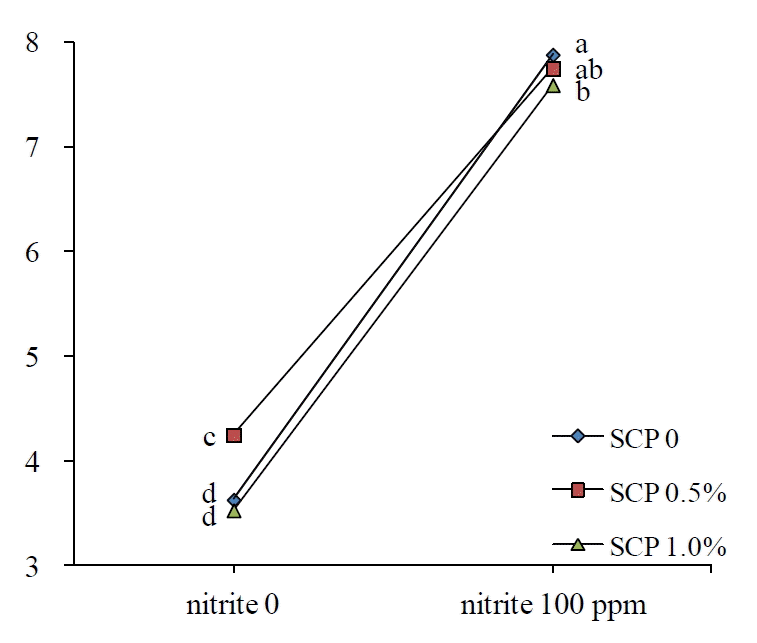
Interaction between nitrite and SCP in the a* color of sausages. a–d Means with different superscript significantly differ at p<0.05.
Treatment with both nitrite and SCP resulted in a significant difference in TBARS, as the TBARS value with no added-SCP was lower in 100 ppm nitrite added-sausages than in no nitrite added-sausages (Figure 3). The concentrations of TBARS after 20 days storage was significantly reduced as the level of SCP addition increased, indicating that fatty acid oxidation was retarded by the presence of SCP. The antioxidant properties of SCP are related to their phenolic contents, and therefore, their antioxidant action is similar to that of 100 ppm nitrite. In particular, the SC extract contained a variety of lignans, schizandrin, gomisin N, and gomisin A, all of which were reported to contain antioxidants (Toda et al., 1988), and to exert antimicrobial effects (Lee and Lim, 1998). In addition, phenolic compounds in SCP, having a large amount of a lignin compounds, may interfere with cholesterol oxidation in meat processing or during the storage of meat products, through its antioxidative action (Osada et al., 2000). Therefore, SCP will be useful as a new antioxidant for meat products when it is added to the original meat before processing.
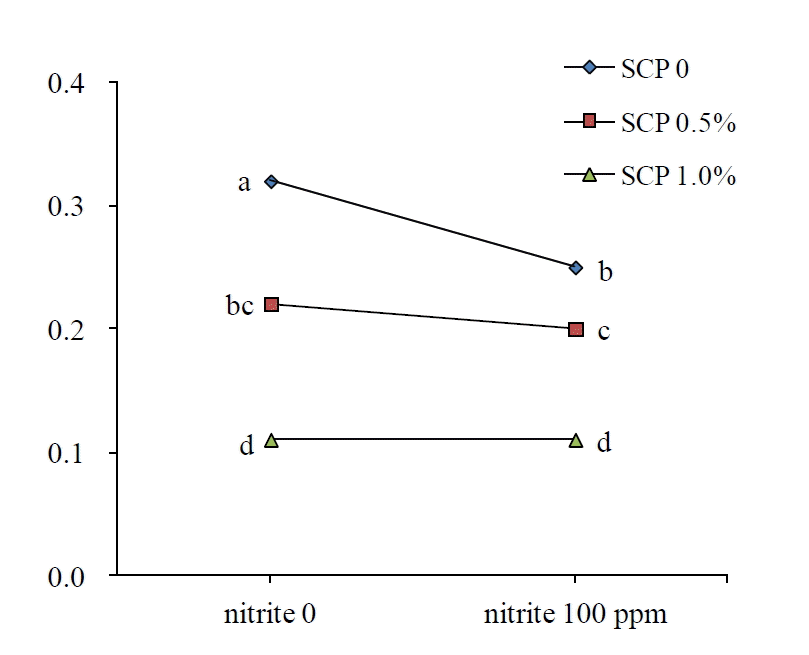
Interaction between nitrite and SCP in TBARS (mg/100 g) of sausages. a–d Means with different superscript significantly differ at p<0.05.
In the sausage sample made with no nitrite, a low concentration (10.44 ppm) of nitrite was present, which decreased as the level of SCP addition increased. It is well known that many phenolic compounds express a nitrite scavenging activity (Chung et al., 1999; Ha et al., 2001). The total phenol content of SC was determined to be 4.6 mg/mL (Kim et al., 2008), and these phenolic compounds might be responsible for the apparent nitrite scavenging activity. The results of our study of SCP additions were similar to previous reports of Kim et al. (2000), which found a greater sausage nitrite scavenging activity for SC treated sausages. The findings of the present study suggest that SCP demonstrated a marked ability to inhibit nitrite formation, and that the plant SC is a good nitric oxide radical scavenger. In the nitrite scavenging activity interaction of nitrite and SCP, there was no difference in the nitrite scavenging activity of nitrite-free sausages between 0.5% SCP and 1.0% SCP treatments, but 1.0% SCP was more effective in the 100 ppm nitrite added-sausages than in the 0 ppm nitrite added-sausage (Figure 2).
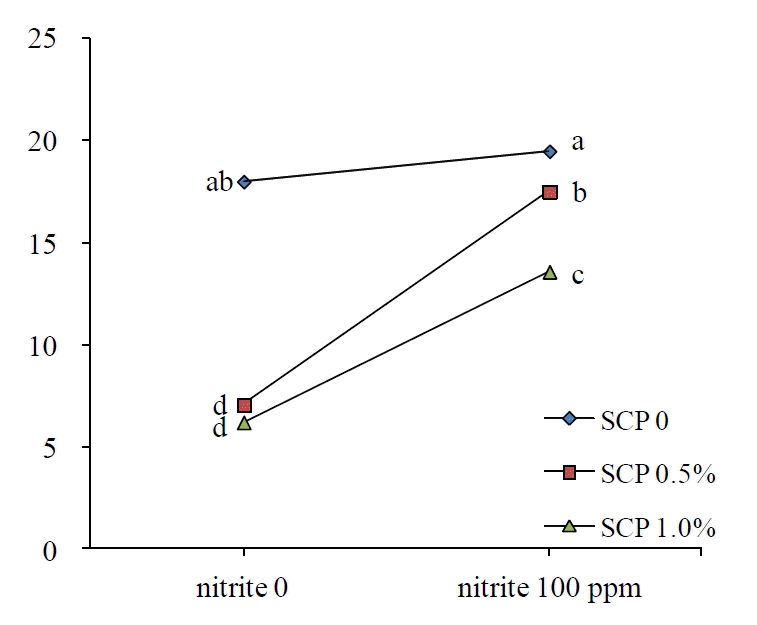
Interaction between nitrite and SCP in residual nitrite (ppm) of sausages. a–d Means with different superscript significantly differ at p<0.05.
The fatty acid content was also affected by the addition of SCP. The PUFA was higher in 0.5% and 1.0% SCP added-sausages than in SCP-free sausages. These result indicate that 1.0% SCP resulted in a decline in the MUFA level. In contrast, SCP stabilized PUFA. These results indicate an effective protection of linoleic acid and arachidonic acid degradation by SCP. Improvement of preservation of PUFA may have been caused by the antioxidative properties of SCP in sausages. Higher levels of PUFA are considered beneficial in relation to consumer health. The PUFA, n-3 and n-6 fatty acid contents in 100 ppm nitrite added-sausage decreased, whereas the MUFA content increased. The present results are not consistent with Seong et al. (2010) who showed that nitrite addition did not affect the PUFA and MUFA contents in pork hams. There are currently no reports of the effects nitrite supplementation has on fatty acid composition in cooked sausages, and whether this contributed to the increase in MUFA and the decrease in PUFA in sausage is unknown. The use of nitrite in changing fatty acids in sausage needs to be further investigated.
The AAA content was significantly higher in 1.0% SCP added-sausages than in those of 0.5% SCP and no SCP. This finding suggests that the existence of AAA in SCP (Shin et al., 1998) may be directly related to the increased content of AAA in sausages. Therefore, the addition of 1.0% SCP may provide important precursors to sausage flavor. SC extracts contain a variety of organic acids, including fumaric acid, malic acid and succinic acid (Moon et al., 2003). These organic acids of SCP assist the action of proteolytic microorganisms and these microorganisms might increase amino acid catabolism. Therefore, SCP accelerate amino acid breakdown, thereby, increasing the release of ammonia.
Textural property results indicate that nitrite affected the hardness, cohesiveness, springiness, gumminess, chewiness and adhesiveness of the sausages. This observation has been well documented by Pegg and Shahidi (2000) who found that nitrite increased firmness. In contrast, SCP decreased all of the physical properties of sausages, except for adhesiveness. These results suggest that the addition of SC powder may result in a greater absorption and retention of moisture in sausages.
Sensory evaluation of sausages containing nitrite, and after 20 d of storage revealed significant differences in the apparent color, depending on the rate of nitrite addition (0 ppm or 100 ppm). The addition of nitrite to sausages scarcely affected the other sensory characteristics, however, the bitter taste of the SCP-added sausage was stronger than those without any addition. This result is in agreement with the report of Kim et al. (2000), who found that the sensory scores were decreased compared with control sausages. Therefore, further studies are needed to develop ways to reduce the bitter taste of SCP.
In conclusion, these results indicate that SCP addition is not an effective way to improve the sensory quality of sausages, but may beneficially affect the TBARS, nitrite scavenging activity, fatty acid and amino acid content in pork sausages.
Acknowledgements
This study was supported by a Gyeongnam National University of Science and Technology Grant, and by the Priority Research Centers Program through the National Research Foundation of Korea (NRF), funded by the Ministry of Education, Science, and Technology (2012-0006683).

